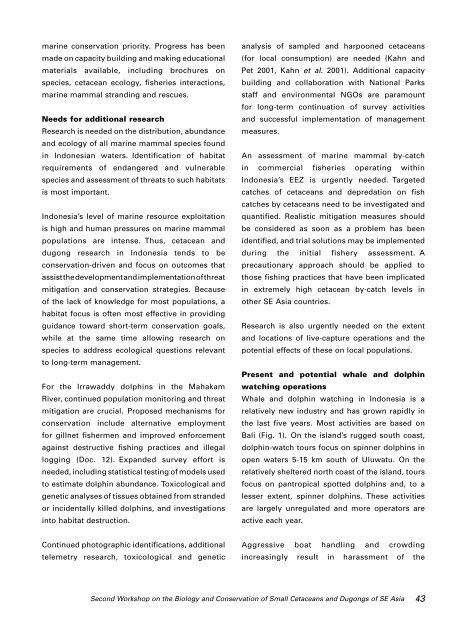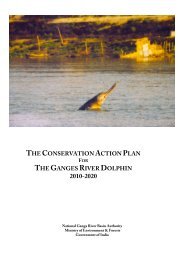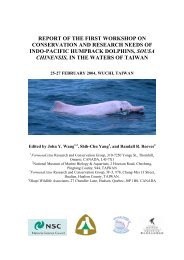Report of the Second Workshop on The Biology and Conservation of ...
Report of the Second Workshop on The Biology and Conservation of ...
Report of the Second Workshop on The Biology and Conservation of ...
You also want an ePaper? Increase the reach of your titles
YUMPU automatically turns print PDFs into web optimized ePapers that Google loves.
marine c<strong>on</strong>servati<strong>on</strong> priority. Progress has beenmade <strong>on</strong> capacity building <strong>and</strong> making educati<strong>on</strong>almaterials available, including brochures <strong>on</strong>species, cetacean ecology, fisheries interacti<strong>on</strong>s,marine mammal str<strong>and</strong>ing <strong>and</strong> rescues.Needs for additi<strong>on</strong>al researchResearch is needed <strong>on</strong> <str<strong>on</strong>g>the</str<strong>on</strong>g> distributi<strong>on</strong>, abundance<strong>and</strong> ecology <str<strong>on</strong>g>of</str<strong>on</strong>g> all marine mammal species foundin Ind<strong>on</strong>esian waters. Identificati<strong>on</strong> <str<strong>on</strong>g>of</str<strong>on</strong>g> habitatrequirements <str<strong>on</strong>g>of</str<strong>on</strong>g> endangered <strong>and</strong> vulnerablespecies <strong>and</strong> assessment <str<strong>on</strong>g>of</str<strong>on</strong>g> threats to such habitatsis most important.Ind<strong>on</strong>esia’s level <str<strong>on</strong>g>of</str<strong>on</strong>g> marine resource exploitati<strong>on</strong>is high <strong>and</strong> human pressures <strong>on</strong> marine mammalpopulati<strong>on</strong>s are intense. Thus, cetacean <strong>and</strong>dug<strong>on</strong>g research in Ind<strong>on</strong>esia tends to bec<strong>on</strong>servati<strong>on</strong>-driven <strong>and</strong> focus <strong>on</strong> outcomes thatassist <str<strong>on</strong>g>the</str<strong>on</strong>g> development <strong>and</strong> implementati<strong>on</strong> <str<strong>on</strong>g>of</str<strong>on</strong>g> threatmitigati<strong>on</strong> <strong>and</strong> c<strong>on</strong>servati<strong>on</strong> strategies. Because<str<strong>on</strong>g>of</str<strong>on</strong>g> <str<strong>on</strong>g>the</str<strong>on</strong>g> lack <str<strong>on</strong>g>of</str<strong>on</strong>g> knowledge for most populati<strong>on</strong>s, ahabitat focus is <str<strong>on</strong>g>of</str<strong>on</strong>g>ten most effective in providingguidance toward short-term c<strong>on</strong>servati<strong>on</strong> goals,while at <str<strong>on</strong>g>the</str<strong>on</strong>g> same time allowing research <strong>on</strong>species to address ecological questi<strong>on</strong>s relevantto l<strong>on</strong>g-term management.For <str<strong>on</strong>g>the</str<strong>on</strong>g> Irrawaddy dolphins in <str<strong>on</strong>g>the</str<strong>on</strong>g> MahakamRiver, c<strong>on</strong>tinued populati<strong>on</strong> m<strong>on</strong>itoring <strong>and</strong> threatmitigati<strong>on</strong> are crucial. Proposed mechanisms forc<strong>on</strong>servati<strong>on</strong> include alternative employmentfor gillnet fishermen <strong>and</strong> improved enforcementagainst destructive fishing practices <strong>and</strong> illegallogging (Doc. 12). Exp<strong>and</strong>ed survey effort isneeded, including statistical testing <str<strong>on</strong>g>of</str<strong>on</strong>g> models usedto estimate dolphin abundance. Toxicological <strong>and</strong>genetic analyses <str<strong>on</strong>g>of</str<strong>on</strong>g> tissues obtained from str<strong>and</strong>edor incidentally killed dolphins, <strong>and</strong> investigati<strong>on</strong>sinto habitat destructi<strong>on</strong>.analysis <str<strong>on</strong>g>of</str<strong>on</strong>g> sampled <strong>and</strong> harpo<strong>on</strong>ed cetaceans(for local c<strong>on</strong>sumpti<strong>on</strong>) are needed (Kahn <strong>and</strong>Pet 2001, Kahn et al. 2001). Additi<strong>on</strong>al capacitybuilding <strong>and</strong> collaborati<strong>on</strong> with Nati<strong>on</strong>al Parksstaff <strong>and</strong> envir<strong>on</strong>mental NGOs are paramountfor l<strong>on</strong>g-term c<strong>on</strong>tinuati<strong>on</strong> <str<strong>on</strong>g>of</str<strong>on</strong>g> survey activities<strong>and</strong> successful implementati<strong>on</strong> <str<strong>on</strong>g>of</str<strong>on</strong>g> managementmeasures.An assessment <str<strong>on</strong>g>of</str<strong>on</strong>g> marine mammal by-catchin commercial fisheries operating withinInd<strong>on</strong>esia’s EEZ is urgently needed. Targetedcatches <str<strong>on</strong>g>of</str<strong>on</strong>g> cetaceans <strong>and</strong> depredati<strong>on</strong> <strong>on</strong> fishcatches by cetaceans need to be investigated <strong>and</strong>quantified. Realistic mitigati<strong>on</strong> measures shouldbe c<strong>on</strong>sidered as so<strong>on</strong> as a problem has beenidentified, <strong>and</strong> trial soluti<strong>on</strong>s may be implementedduring <str<strong>on</strong>g>the</str<strong>on</strong>g> initial fishery assessment. Aprecauti<strong>on</strong>ary approach should be applied tothose fishing practices that have been implicatedin extremely high cetacean by-catch levels ino<str<strong>on</strong>g>the</str<strong>on</strong>g>r SE Asia countries.Research is also urgently needed <strong>on</strong> <str<strong>on</strong>g>the</str<strong>on</strong>g> extent<strong>and</strong> locati<strong>on</strong>s <str<strong>on</strong>g>of</str<strong>on</strong>g> live-capture operati<strong>on</strong>s <strong>and</strong> <str<strong>on</strong>g>the</str<strong>on</strong>g>potential effects <str<strong>on</strong>g>of</str<strong>on</strong>g> <str<strong>on</strong>g>the</str<strong>on</strong>g>se <strong>on</strong> local populati<strong>on</strong>s.Present <strong>and</strong> potential whale <strong>and</strong> dolphinwatching operati<strong>on</strong>sWhale <strong>and</strong> dolphin watching in Ind<strong>on</strong>esia is arelatively new industry <strong>and</strong> has grown rapidly in<str<strong>on</strong>g>the</str<strong>on</strong>g> last five years. Most activities are based <strong>on</strong>Bali (Fig. 1). On <str<strong>on</strong>g>the</str<strong>on</strong>g> isl<strong>and</strong>’s rugged south coast,dolphin-watch tours focus <strong>on</strong> spinner dolphins inopen waters 5-15 km south <str<strong>on</strong>g>of</str<strong>on</strong>g> Uluwatu. On <str<strong>on</strong>g>the</str<strong>on</strong>g>relatively sheltered north coast <str<strong>on</strong>g>of</str<strong>on</strong>g> <str<strong>on</strong>g>the</str<strong>on</strong>g> isl<strong>and</strong>, toursfocus <strong>on</strong> pantropical spotted dolphins <strong>and</strong>, to alesser extent, spinner dolphins. <strong>The</strong>se activitiesare largely unregulated <strong>and</strong> more operators areactive each year.C<strong>on</strong>tinued photographic identificati<strong>on</strong>s, additi<strong>on</strong>altelemetry research, toxicological <strong>and</strong> geneticAggressive boat h<strong>and</strong>ling <strong>and</strong> crowdingincreasingly result in harassment <str<strong>on</strong>g>of</str<strong>on</strong>g> <str<strong>on</strong>g>the</str<strong>on</strong>g><str<strong>on</strong>g>Sec<strong>on</strong>d</str<strong>on</strong>g> <str<strong>on</strong>g>Workshop</str<strong>on</strong>g> <strong>on</strong> <str<strong>on</strong>g>the</str<strong>on</strong>g> <strong>Biology</strong> <strong>and</strong> C<strong>on</strong>servati<strong>on</strong> <str<strong>on</strong>g>of</str<strong>on</strong>g> Small Cetaceans <strong>and</strong> Dug<strong>on</strong>gs <str<strong>on</strong>g>of</str<strong>on</strong>g> SE Asia 43





